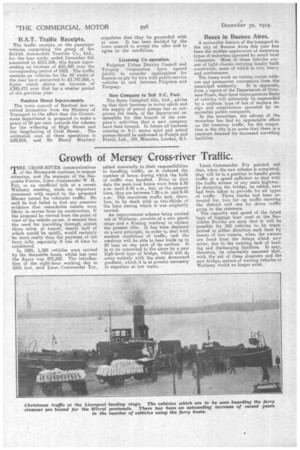Growth of Mersey Cross-river Traffic.
Page 8

If you've noticed an error in this article please click here to report it so we can fix it.
THE CROSS-RIVER communications of the Merseyside continue to engage attention, and the manager of the Seacombe Ferries, Lieut.-Commander W. H. Fry, in an unofficial talk at a recent Wallasey meeting, made an important statement with regard to the proposed Mersey tunnel for vehicular traffic. He said he had failed to find any concrete evidence that remarkable results were likely to accrue from its construction. If the proposal be viewed from the point of view of the vehicle owner, it seemed that the need for travelling through almost three miles of tunnel, nearly half of which would be uphill, would certainly be more costly than the payment of the ferry tolls, especially if loss of time be considered.
In 1880, 1,500 vehicles were carried by the Seacombe boats, whilst last year the figure was 273,523. The introduction of the eight-hour working day in 1916 had, Said Lieut.-Commander Fry,
added materially to their responsibilities in handling traffic, as it reduced the number of hours during which the bulk of traffic was handled. Prior to that date the peak-load hours were from 6.30 a.m. until 9.30 a.m., but,' at the present time, they are between 7.30 a.m. and 9,30 a.m. The maximum traffic had, therefore, to be dealt with in two-thirds of the time during which it was originally carried.
An improvement scheme being carried out at Wallasey, consists of a new goods stage and a floating roadway to replace the present lifts. It has been designed on a -new principle, in order to deal with modern conditions of traffic, and the roadway will* able to bear loads up to 20 tons on any part of its surface. It is to be connected to the shore by a new high-level type of bridge, which will do away entirely with the steep downward gradient, which it is at present necessary to negotiate at low water. Lieut.-Commander Fry pointed out that, when the new scheme is completed, they will be in a position to handle goods traffic at a speed sufficient .to deal with the traffic stream of any main highway. In designing the bridge, lie added, care had been taken to provide for all types of traffic. Three tracks had been arranged for' two for up traffic entering the district and one for down traffic going to the steamers. The capacity and speed of the latest type of luggage boat used at the Seacombe Ferries are such that it will be possible for 160 vehicles to be transported in either direction each hour by means of two vessels' when the owners are freed from the delays which now occur, due to the existing lack of load. ing and discharging facilities. It may, therefore, be reasonably assumed that, with the aid of these steamers and the new bridge-, queues of waiting vehicles at Wallasey would no longer exist.






























